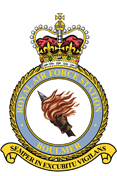Boulmer
Location :3.5 miles East of Alnwick
OS Ref :
NU 257 131
 Boulmer
(actually designated Longhoughton) first saw use
in Spring 1940 as a decoy airfield for Acklington.
It was designed as a KQ type decoy field which meant it was equipped
with dummy buildings and aircraft for day use (K) as well as
simulated runway lighting (Q)in an attempt to divert night raids
away from active airfields.
Boulmer
(actually designated Longhoughton) first saw use
in Spring 1940 as a decoy airfield for Acklington.
It was designed as a KQ type decoy field which meant it was equipped
with dummy buildings and aircraft for day use (K) as well as
simulated runway lighting (Q)in an attempt to divert night raids
away from active airfields.
The establishment of a real aerodrome started during 1942 when the land was requisitioned by the Air Ministry. On completion, the station was equipped with three tarmac runways in a triangular configuration (01/19 - 1,800 x 50 yards, 06/24 - 1,400 x 50 yards & 15/33 - 1,300 x 50 yards). The perimeter track that linked the runways included twenty-five dispersals. Hangarage consisted of four Dorman Blister hangars, two to the North side and two to the South side of the site. A T2-Type hangar was planned, but was never built. The main buildings including watch office (control tower), crew rooms and offices were all located on the North West side of the airfield just off the perimeter track linking runways 15 and 19.
57OTU who were based at nearby Eshott used Boulmer as a satellite from March 1943 until the unit disbanded at the end of the Second World War, the airfield being placed under care and maintenance and only used as a relief landing ground from units based at Acklington. In November 1943 Boulmer became home to No 9 Battle Training School, in which night flying, dive-bombing, strafing, bouncer, and chase tactics were taught.
In the early 1950's as the intensity of the Cold War was growing, Boulmer was selected for the construction of an Air Defence Control Centre. Additional land away from the original airfield was acquired and in June 1953 the airfield re-opened when No. 500 Signals Unit took residence under the control of Acklington. In October 1954 an underground operations centre was completed and Boulmer became an independent station for the first time.
In Autumn 1957 Boulmer was designated a Group Control Centre and became responsible for the stations at Buchan and Killard Point. The following year the station was upgraded with Type 84 & Type 85 radars which were to form the backbone of a new centralized air defence system for the UK. As the Cold War continued, so did the development of the UK Air Defence infrastructure. Boulmer's responsibility increased into the 1970's becoming both a Sector Operations Centre (SOC) and Control and Reporting Centre (CRC) by 1974.
In 1978 aircraft returned in the rotary variety when 202Sqn made the short journey from Acklington to take up SAR duties from a site to the North of the original airfield.
Today, even with the Cold War over Boulmer still plays an important role as the hub station for the Air Surveillance and Control System (ASACS) with 202Sqn still in residence with Sea King's for Search and Rescue (SAR) duties.
Based units
| Unit | Arrived From | Arrival Date | Dept Date | Departed To | Aircraft |
| 57OTU (Satellite) |
Eshott | 01/03/1943 | 06/06/1945 | Disbanded | Spitfire, Master |
| 202Sqn (Det) | Acklington | 1978 | Current | Current | Whirlwind / Sea King |
